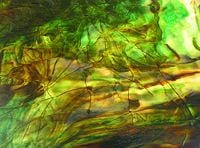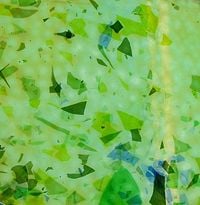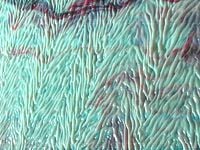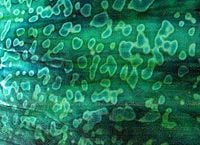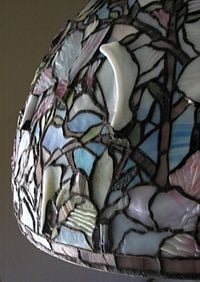Tiffany Glass
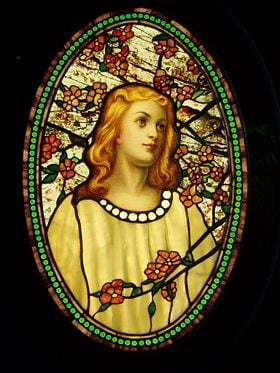
Tiffany glass is the generic name used here to describe the many and varied types of glass developed and produced by Louis Comfort Tiffany, (1848-1933), one of the most famous stained glass artists of the United States and remembered not only for his windows but for decorative glass objects, in particular so-called Tiffany lamps.
In 1865 Tiffany traveled to Europe and in London he visited the Victoria and Albert Museum, whose extensive collection of Roman and Syrian glass made a deep impression on him. He admired the coloration of medieval glass and was convinced that the quality of contemporary glass could be improved upon.
In his own words, the "Rich tones are due in part to the use of pot metal full of impurities, and in part to the uneven thickness of the glass, but still more because the glass maker of that day abstained from the use of paint".
Tiffany was an interior designer, and in 1878 his interest turned towards the creation of stained glass, when he opened his own studio and glass foundry because he was unable to find the types of glass that he desired in interior decoration. His inventiveness both as a designer of windows and as a producer of the material with which to create them was to become renowned. [1]
Tiffany wanted the glass itself to transmit texture and rich colors and he developed a type of glass he called Favrile. Some of the most significant products of Tiffany's glass manufacture are described here.
Types of Tiffany glass
Opalescent glass
The term "opalescent glass" is commonly used to describe glass where more than one colour is present, being fused during the manufacture, as against "flashed" glass in which two colours may be laminated, or silver stained glass where a solution of silver nitrate is superficially applied, turning red glass to orange and blue glass to green. Some opalescent glass was used by several stained glass studios in England from the 1860s and 1870s onwards, notably Heaton, Butler and Bayne. Its use became increasingly common. Opalescent glass is the basis for the range of glasses created by Tiffany.[2]
Favrile glass
Tiffany patented Favrile glass in 1880. The trade name "Favrile" was derived from the French word, fabrile, meaning handcrafted.
Favrile glass often has a distinctive characteristic that is common in some glass from Classical antiquity: it possesses a superficial iridescence. This iridescence causes the surface to shimmer, but also causes a degree of opacity. This iridescent effect of the glass was obtained by mixing different colors of glass together while hot.
According to Tiffany:
"Favrile glass is distinguished by brilliant or deeply toned colors, usually iridescent like the wings of certain American butterflies, the necks of pigeons and peacocks, the wing covers of various beetles."
Streamer glass
Streamer glass refers to a sheet of glass with a pattern of glass strings affixed to its surface. Tiffany made use of such textured glass to represent, for example, twigs, branches and grass.
Streamers are prepared from very hot molten glass, gathered at the end of a punty (pontil) that is rapidly swung back and forth and stretched into long, thin strings that rapidly cool and harden. These hand-stretched streamers are pressed on the molten surface of sheet glass during the rolling process, and become permanently fused.
Fracture glass
Fracture glass refers to a sheet of glass with a pattern of irregularly shaped, thin glass wafers affixed to its surface. Tiffany made use of such textured glass to represent, for example, foliage seen from a distance.
The irregular glass wafers, called "fractures," are prepared from very hot, colored molten glass, gathered at the end of a blowpipe. A large bubble is forcefully blown until the walls of the bubble rapidly stretch, cool and harden. The resulting glass bubble has paper-thin walls and is immediately shattered into shards. These hand blown shards are pressed on the surface of the molten glass sheet during the rolling process, to which they become permanently fused.
Fracture-streamer glass
Fracture-streamer glass refers to a sheet of glass with a pattern of glass strings, and irregularly shaped, thin glass wafers, affixed to its surface. Tiffany made use of such textured glass to represent, for example, twigs, branches and grass, and distant foliage.
Streamers are prepared from very hot molten glass, gathered at the end of a punty (pontil) that is rapidly swung back and forth and stretched into long, thin strings that rapidly cool and harden.
The irregular glass wafers, called "fractures," are prepared from very hot, colored molten glass, gathered at the end of a blowpipe. A large bubble is forcefully blown until the walls of the bubble rapidly stretch, cool and harden. The resulting glass bubble has paper-thin walls and is immediately shattered into shards.
These hand-stretched streamers and hand blown shards are pressed on the surface of the molten glass sheet during the rolling process, to which they become permanently fused.
Ripple glass
Ripple glass refers to a sheet of textured glass with marked surface waves. Tiffany made use of such textured glass to represent, for example, water or leaf veins.
The texture is created during the glass sheet-forming process. A sheet is formed from molten glass with a roller that spins on itself, while travelling forward. Normally the roller spins at the same speed as its own forward motion, and the resulting sheet has a smooth surface. In the manufacture of rippled glass, the roller spins faster than its own forward motion. The rippled effect is retained as the glass cools.
Ring mottle glass
Ring mottle glass refers to sheet glass with a pronounced mottle created by localized, heat-treated opacification and crystal-growth dynamics. Ring mottle glass was invented by Louis Comfort Tiffany in the early 20th century. Tiffany's distinctive style exploited glass containing a variety of motifs such as those found in ring mottle glass, and he relied minimally on painted details.
When Tiffany Studio closed in 1928, the secret formula for making ring mottle glass was forgotten and lost.
Ring mottle glass was "re-invented" in the late sixties by Eric Lovell of Uroboros Glass.
Traditionally used for organic details on leaves and other natural elements, ring mottles also find a place in contemporary work when abstract patterns are desired.
Drapery glass
Drapery glass refers to a sheet of heavily folded glass that suggests fabric folds. Tiffany made adundant use of drapery glass in ecclesiastical stained glass windows to add a 3-dimensional effect to flowing robes and angel wings, and to imitate the natural coarseness of magnolia petals.
The making of drapery glass requires skill and experience. A small diameter hand-held roller is manipulated forcefully over a sheet of molten glass to produce heavy ripples, while folding and creasing the entire sheet. The ripples become rigid and permanent as the glass cools. Each sheet produced from this artisanal process is unique.
Techniques for cutting Tiffany glass
In order to cut streamer, fracture or ripple glass, the sheet may be scored on the side without streamers, fractures or ripples with a carbide glass cutter, and broken at the score line with breaker-grozier pliers.
In order to cut drapery glass, the sheet may be placed on styrofoam, scored with a carbide glass cutter, and broken at the score line with breaker-grozier pliers, but a bandsaw or ringsaw are the preferred tools.
ReferencesISBN links support NWE through referral fees
- ↑ Lawrence Lee, George Seddon, Francis Stephens, Stained Glass, 1976, Spring Books ISBN 0-600-56281-6
- ↑ The use of the term "opalescent" is actually a misnomer. Opalescence actually refers to the quality of changing colour under transmitted light, rather than the quality of having several colours present. A rare example of true opalescent glass is the Roman Lycurgus cup in the British Museum
- Lawrence Lee, George Seddon, Francis Stephens, Stained Glass, 1976, Spring Books ISBN 0-600-56281-6
Credits
New World Encyclopedia writers and editors rewrote and completed the Wikipedia article in accordance with New World Encyclopedia standards. This article abides by terms of the Creative Commons CC-by-sa 3.0 License (CC-by-sa), which may be used and disseminated with proper attribution. Credit is due under the terms of this license that can reference both the New World Encyclopedia contributors and the selfless volunteer contributors of the Wikimedia Foundation. To cite this article click here for a list of acceptable citing formats.The history of earlier contributions by wikipedians is accessible to researchers here:
The history of this article since it was imported to New World Encyclopedia:
Note: Some restrictions may apply to use of individual images which are separately licensed.
